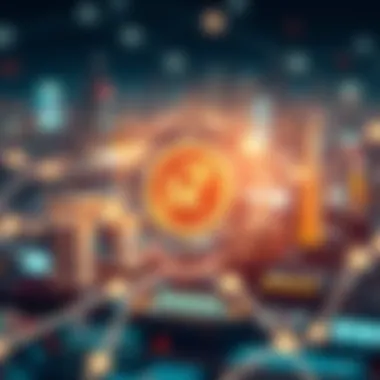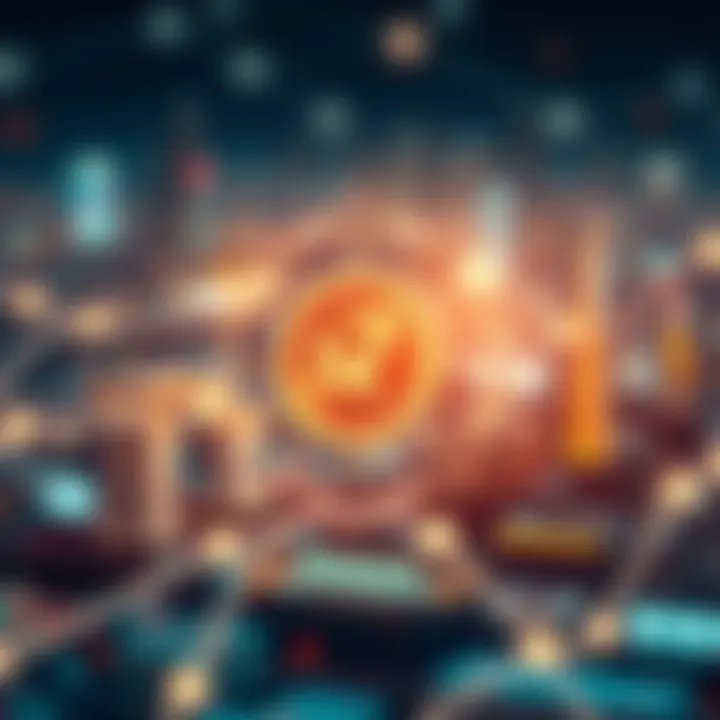Decoding the World of IoT Tokens: Insights and Impacts


Intro
In today's rapidly evolving technological landscape, the Internet of Things (IoT) stands as a pillar of innovation. With devices connected to the internet, we are witnessing an unprecedented surge in data-sharing possibilities. At the intersection of IoT and cryptocurrency, a new player has emerged: IoT tokens. These tokens offer unique functionalities that extend the boundaries of how we may think about digital assets.
The significance of IoT tokens goes beyond mere speculation or investment opportunities. They enable devices to communicate securely and efficiently, leading to automation across various sectors. From smart homes to industrial applications, the potential for optimization and cost savings is substantial. As we dive deeper, we'll explore what these tokens represent within the cryptocurrency ecosystem and how they could shape our future.
Staying informed about IoT tokens is not just for tech enthusiasts or investors. Marketers, analysts, and students stand to benefit from understanding the underlying principles of this paradigm shift. By comprehending the essentials of IoT tokens, one can better navigate the evolving landscape and harness the opportunities it presents.
Let us embark on this journey to decode IoT tokens and shed light on their complexities, use cases, and the myriad of possibilities that lie ahead.
Understanding IoT Tokens
The exploration of IoT tokens is pivotal in grasping the convergence of technology and finance in our increasingly connected world. These tokens represent a novel approach to harnessing the capabilities of the Internet of Things (IoT) by integrating them with blockchain technology. By delving into what IoT tokens are and how they function, individuals can unlock their potential advantages and implications in various sectors. This understanding is especially crucial for marketers, investors, tech professionals, students, and analysts who aim to stay ahead in the dynamic tech landscape.
Defining the Concept
To contextualize IoT tokens, we first need to step back and clarify what we mean by 'IoT.' The Internet of Things encompasses a network of physical objects embedded with sensors, software, and other technologies that allow them to connect and exchange data with other devices and systems over the internet.
So, where do tokens fit into this? In essence, IoT tokens act as digital assets or currencies specifically designed for the unique needs of IoT ecosystems. They enable the exchange of data, services, and even value between diverse devices. Think of them as the currency that allows smooth transactions within this interconnected network.
The appeal of these tokens lies in their ability to facilitate seamless microtransactions, driving efficiencies that traditional payment systems might struggle to manage. For instance, an autonomous vehicle could use tokens to pay for charging at a station or make small transactions for local traffic data, all without human intervention.
Historical Context
The origin of IoT tokens can be traced back to the broader developments in blockchain technology, which emerged with Bitcoin in 2009. The idea of creating decentralized networks that could operate without intermediaries laid the groundwork for innovations across various fields, including IoT. More recently, as IoT devices proliferated, the necessity for reliable, low-cost methods to manage transactions became glaringly evident.
In the mid-2010s, various projects, such as IOTA, emerged with the aim of creating specific tokens designed for IoT applications. IOTA's unique Tangle technology, which differentiates it from traditional blockchains, allows for feeless transactions between devices, thus catering specifically to the needs of a booming IoT economy.
As the technology evolved, so did the ecosystem surrounding IoT tokens. We’ve seen a gradual shift towards mainstream acceptance, with increasing interest from industries like supply chain management and healthcare. Each industry has recognized the need for efficient token-based frameworks to enhance connectivity, data sharing, and ultimately, service delivery.
"The future of IoT tokens is not merely about technology but also about creating new economic models that adapt to our changing world."
This historical context is crucial for understanding how we arrived at the current landscape of IoT tokens. The continuous advancement in technology, coupled with heightened demand for automation and efficiency, speaks to the importance of understanding these tokens as indispensable in our fast-evolving digital economy.
Technological Framework of IoT Tokens
The technological framework surrounding IoT tokens is pivotal for understanding their functionality and potential impact on various sectors. It serves as the backbone for integrating devices and facilitating transactions securely and efficiently. This section gives an insightful overview of two primary elements that form this framework: blockchain technology and the synergy between IoT and blockchain.
Blockchain Technology Fundamentals
Blockchain technology is more than just the foundation of cryptocurrencies; it’s a disruptive force across multiple industries, including IoT. At its core, blockchain is a decentralized digital ledger that records transactions across many computers so that the registered transactions cannot be altered retroactively. This characteristic makes it exceptionally secure and transparent.
The key benefits of blockchain technology in the context of IoT tokens include:
- Security: The decentralized nature of blockchain reduces the risk of data breaches, a significant concern for IoT devices that often lack robust security features.
- Transparency: All transactions are recorded in an immutable manner, allowing stakeholders to have a clear view of the operations and interactions.
- Efficiency: By streamlining operations and eliminating intermediaries, blockchain can facilitate faster transactions, saving both time and costs.
Moreover, the concept of smart contracts—self-executing contracts with the agreement directly written into code—allows IoT devices to autonomously manage transactions. For instance, a smart contract could regulate the payment for electricity consumption of a smart home by triggering payments when specific usage thresholds are met.
"The future of IoT is anchored to the innovations in blockchain technology, ensuring a safer and more streamlined interaction among devices and users."


How IoT Integrates with Blockchain
The integration of IoT with blockchain technology addresses several challenges faced by IoT frameworks today. When devices communicate over the network, they generate vast amounts of data. However, without a reliable method for securing this data, the potential for misuse increases.
Here’s how the integration unfolds:
- Data Integrity: Blockchain ensures that data generated by IoT devices is secure and tamper-proof. Once data is recorded on the blockchain, it becomes difficult to alter, thus ensuring its integrity.
- Scalability: As the number of IoT devices continues to grow—expect tens of billions of devices to be connected by 2030—traditional databases may struggle to manage the data flow. Blockchain offers a solution through decentralized storage, allowing for scalability by distributing the data across multiple nodes.
- Access Control: Through smart contracts, there is potential for sophisticated access control mechanisms. Devices can grant or restrict access based on pre-defined conditions, thereby enhancing security.
The intersection of IoT and blockchain exemplifies a paradigm shift in how businesses will operate in the future. Organizations can leverage these technologies not just to innovate but also to gain a competitive edge, especially in industries like logistics, healthcare, and manufacturing.
Overall, the technological framework of IoT tokens positions itself as a critical component bridging the existing gap between device automation and secure transactions, setting the stage for a more connected and efficient future.
The Role of Tokens in IoT Ecosystems
As we step into the intricate web of Internet of Things (IoT), tokens rise to prominence as essential cogs in ensuring the smooth operation of these systems. The role of tokens within IoT ecosystems cannot be understated; they facilitate a multitude of processes critical for functionality, security, and interaction between devices and users alike. In this section, we will delve into two pivotal aspects of tokens in IoT: facilitating transactions and data monetization. Each serves not only to streamline processes but also to unlock new avenues of revenue and efficiency in various industries.
Facilitating Transactions
With devices increasingly interconnected, facilitating seamless transactions is key to IoT's overall efficacy. Tokens serve as the currency for these interactions, enabling real-time exchanges between devices without the need for central authority oversight. This decentralized mechanism provides a layer of security and transparency, assuring users that their transactions are not susceptible to tampering.
Using tokens, devices like smart appliances, vehicles, and wearables can autonomously execute transactions. For example:
- Smart contracts can be executed on the blockchain, automating payments between users and service providers.
- IoT devices in logistics can automatically bill clients when certain conditions are met, say when goods are delivered or temperature thresholds are maintained.
"Tokens catalyze IoT transactions, enhancing efficiency and trust across systems."
What makes this facilitation particularly noticeable is the reduced operational overhead. Traditional payment processes often involve banks and intermediaries, introducing delay and costs. In contrast, tokens streamline these interactions, using blockchain to create a lien-less environment. As transactions become more efficient, the potential for instant payments and real-time interactions becomes a reality, shifting the dynamics of commerce and service delivery.
Data Monetization
Beyond immediate transactions, tokens bring a new flavor to the concept of data monetization in the IoT landscape. In an era where data is often termed the new oil, the mechanics of how data is gathered, owned, and traded are ever-evolving. IoT devices generate an immense amount of data, which can be leveraged in various ways, particularly for organizations seeking to maximize investments in technology.
Through tokenization, data becomes an asset that can be bought, sold, or traded within the ecosystem. Here's how data monetization manifests:
- Token-based rewards incentivize users to share their data willingly, creating a win-win scenario. Users receive tokens in exchange for their data, while companies gain access to valuable insights.
- Marketplaces can be created specifically for data trading, allowing organizations to purchase relevant datasets that enhance their decisions and operations.
The implications here are profound. For instance, in healthcare, patient data collected from IoT-enabled devices can lead to better research and treatment plans when appropriately monetized and shared securely. Similarly, in smart city initiatives, aggregated data can help municipal planners optimize resources effectively by understanding traffic patterns and service usage.
As we move forward in the IoT landscape, the role of tokens in facilitating transactions and enabling data monetization will only become more integral, paving the way for even more sophisticated applications and widespread industry change.
For further insights, explore resources such as Wikipedia and Britannica to dig deeper into blockchain technologies tied to IoT.
Use Cases of IoT Tokens
The importance of understanding the use cases of IoT tokens cannot be overstated. These tokens are revolutionizing various industries by facilitating efficiency, enhancing data security, and creating new avenues for monetization. As the IoT landscape expands, the use of tokens becomes increasingly pivotal in ensuring seamless interactions among devices and their users. From smart homes to healthcare innovations, IoT tokens serve a wide array of applications that drive both practical and economic benefits.
Smart Home Applications
In the realm of smart homes, IoT tokens play a crucial role in creating a more connected and automated environment. Devices like smart thermostats, security cameras, and lighting systems employ tokens to authenticate usage and facilitate transactions between devices. For instance, a homeowner can use a token to grant temporary access to a smart door lock for a guest, ensuring that security remains tight while allowing flexibility.
Moreover, smart home applications often leverage tokens to incentivize energy-saving behavior. For example, using a token-based system, homeowners might earn rewards for reducing electricity usage during peak hours. This model doesn't just benefit individual users; it supports power grids by helping manage supply and demand.


"IoT tokens are the key to unlocking new opportunities within home automation, making lives easier and more efficient."
Supply Chain Management
IoT tokens find significant applicability in supply chain management as well. The integration of sensors and devices throughout the supply chain allows for real-time tracking of goods, from manufacturing to delivery. Tokens can store and verify data related to the movement and condition of products, reducing fraud and errors.
For instance, blockchain-driven IoT applications can ensure that each item is accompanied by a token, verifying its authenticity and origin. This not only builds trust among consumers but also simplifies the process of recalls if any issues arise. Additionally, using tokens in supply chain logistics can streamline payment processes, automating transactions as goods pass through various checkpoints.
- Benefits of IoT Tokens in Supply Chains:
- Enhanced transparency throughout the supply chain.
- Reduction of operational costs through automation.
- Minimization of losses from counterfeit products.
Healthcare Innovations
The healthcare sector stands to benefit immensely from the use of IoT tokens. These tokens ensure secure transactions when medical devices collect and transmit sensitive patient data. With rising concerns around data privacy, tokens can act as a shield, ensuring that only authorized personnel access this information. For example, a patient wearing a health monitor can have their data securely transmitted to doctors using token encryption, which helps protect sensitive health information.
Furthermore, IoT tokens can also facilitate the management of healthcare resources. Hospitals are leveraging token-based systems to monitor and manage medical inventories, ensuring that supplies are replenished promptly and efficiently. This innovation not only enhances patient care but also drives down costs by minimizing waste.
- Key Areas of Impact in Healthcare:
- Improvement in patient data security.
- Efficient resource management.
- Streamlined communication among healthcare providers.
Challenges Faced by IoT Tokens
The landscape of IoT tokens is not devoid of challenges. While these tokens offer potential for enhancing the interconnectivity and efficiency of device ecosystems, they also face significant hurdles that must be addressed for broader acceptance and utility. Understanding these issues is vital, as they can dictate not only the future of IoT tokens but also their role within the larger context of technology and business. Below are two major challenges: security vulnerabilities and scalability issues.
Security Vulnerabilities
When it comes to IoT tokens, security is paramount. Devices connected to the Internet of Things often have varying levels of security, making them attractive targets for malicious activities. Cybercriminals can exploit these weaknesses, compromising not just the connected devices, but entire networks.
Here are a few key points to consider regarding security vulnerabilities in IoT tokens:
- Data Interception: Tokens facilitate the exchange of information between devices. If these communications are not properly encrypted, sensitive data could be intercepted, leading to breaches and privacy violations. Examples include personal health information in smart medical devices, which, when leaked, can have dire consequences.
- Smart Contracts and Vulnerabilities: Tokens often rely on smart contracts - self-executing contracts with the terms directly written into code. If there are vulnerabilities in this code, hackers could manipulate transactions. This was visible in the 2016 DAO hack, where a flaw was exploited, leading to a significant loss of funds.
- Device Authentication: Ensuring that each device linked to a token can be trusted is crucial. Weak authentication measures can allow unauthorized access, which could lead to fraudulent transaction manipulations.
"In a world increasingly reliant on connected devices, addressing security vulnerabilities is an urgent priority. Without robust measures, the trust needed for widespread adoption of IoT tokens could erode quickly."
Scalability Issues
Scalability is another critical challenge facing IoT tokens. As the number of connected devices grows, so does the need for a token system that can handle increasing transactions, traffic, and data exchange without compromising performance.
Here's what contributes to scalability issues:
- Network Congestion: With millions of devices transmitting data, networks can become congested. This congestion can slow down response times, making IoT applications less effective. For instance, in smart cities where real-time data processing is crucial, delays can disrupt essential services like traffic management.
- Transaction Speed: Many blockchain systems currently do not support the high speeds required for handling vast data volumes generated by IoT devices. If transaction speeds do not improve, the flow of data and, consequently, actions based on that data could be hampered.
- Energy Efficiency: Oftentimes, the energy consumption of keeping numerous devices connected and operational for seamless transactions can become detrimental. Finding balance between energy use and maintaining a fluid ecosystem is key to promoting sustainable growth.
In sum, while IoT tokens show a promising future, overcoming these challenges is vital for them to flourish in practical applications. As investors, tech professionals, and marketing specialists delve into this evolving market, addressing security and scalability must be prioritized for successful implementation.
Regulatory Landscape
The regulatory landscape surrounding IoT tokens is a crucial factor, shaping not just the technology but the broader ecosystem in which it operates. Understanding how regulations influence IoT tokens can aid investors, marketers, tech professionals, and students alike in navigating this complex terrain. As regulations evolve, so does the potential for innovations and the pitfalls of non-compliance. Thus, keeping abreast of these regulations is paramount.


Current Regulations
Regulatory entities worldwide are beginning to recognize the significance of IoT and its underlying token infrastructure. Here are some key points concerning current regulations:
- Privacy Regulations: Many countries enforce stringent data protection laws that impact how IoT tokens manage user data. For instance, the General Data Protection Regulation (GDPR) in the European Union compels companies to adhere to strict protocols, impacting their use of tokens in data sharing and transactions.
- Financial Regulations: Various jurisdictions categorize cryptocurrencies and tokens under securities, necessitating registrations and compliance with securities laws. For example, the U.S. Securities and Exchange Commission (SEC) scrutinizes Initial Coin Offerings (ICOs) to determine if they breach trading regulations.
- Data Ownership Rules: Regulations often stipulate who owns the data collected by IoT devices. This can affect how tokens are structured for data monetization, impacting the revenue models for businesses relying on IoT technologies.
The impact of these regulatory measures extends to businesses, shaping their operational strategies and development paths. Compliance is not optional; it is a fundamental prerequisite for credibility and longevity within the market.
Implications for Future Developments
As we gaze into the crystal ball of the IoT token ecosystem, the implications of current regulations present both challenges and opportunities:
- Innovation Stifling or Encouragement: Striking a balance in regulations could either stifle innovation or foster it. For example, overly tight regulations may deter startups from exploring new ideas in IoT tokens. Conversely, well-crafted regulations can create a safer environment, encouraging investment.
- Market Dynamics: Regulations can impact market dynamics significantly. Entities that ensure compliance may enjoy a competitive advantage, gaining consumer trust and attracting investors willing to support legitimate operations. Meanwhile, non-compliant organizations might face backlash, limiting their market reach.
- Global Collaboration: Different jurisdictions may develop varying regulations, creating a convoluted framework for IoT token operations. This might catalyze global bodies to work together towards unified regulations, encouraging smoother international transactions and operations.
- Advancements in Security Protocols: As regulatory bodies demand enhanced security measures, businesses will have to innovate continually. This could mean the integration of advanced encryption techniques and privacy-preserving technologies, guaranteeing safer transactions for IoT tokens.
In summary, the evolving regulatory landscape offers critical insights for stakeholders in the IoT token space. By understanding current regulations and their implications, businesses can navigate potential hurdles and seize opportunities that lie ahead, ultimately contributing to the growth and validation of IoT tokens on a global scale.
"In the world of cryptocurrencies and tokens, laws and regulations are the unwritten rules that dictate the game. Every player must be aware, for the stakes are high and the consequences of ignorance can be dire."
For more about regulations applicable to blockchain and IoT, you can check sources such as Wikipedia and NIST.
Future Trends in IoT Tokens
The future of IoT tokens represents a blend of innovation and necessity. As technology evolves, so too will the ways in which tokens are utilized within the Internet of Things framework. Understanding this evolution is crucial for marketers, investors, and technology professionals who are looking to stay ahead of the curve. With an increasing number of devices becoming connected to the internet, the role of tokens will expand dramatically not just to facilitate transactions but also to enhance interoperability and security among devices.
Emerging Technologies
Several emerging technologies are shaping the landscape of IoT tokens, making them more integral to seamless operations in industries including supply chain, healthcare, and smart cities. Among these, 5G connectivity stands out, with its promise of higher speeds and lower latency. This technology can enable real-time data transfer between devices, making it easier to manage tokenized transactions efficiently. Another promising advancement is edge computing, which brings computational power closer to the source of data generation, reducing delays and enhancing privacy.
Furthermore, artificial intelligence (AI) and machine learning (ML) are set to transform how IoT tokens analyze data flows. With AI, devices can make more informed decisions about when and how to utilize tokens for various operations, optimizing both performance and resource allocation. As these technologies mature, they will likely bolster the functionality of IoT tokens, enhancing user experiences by offering tailor-made solutions—all while ensuring data is handled securely.
"Emerging technologies have the potential to revolutionize how we perceive and utilize IoT tokens, moving beyond mere transactions to encompass a whole ecosystem of interactions and connections."
Predictions for Market Growth
The market for IoT tokens is poised for significant growth over the next few years. Experts predict a compound annual growth rate (CAGR) that could reach double digits as companies find more innovative uses for these tokens. For example, with the rise of decentralized finance (DeFi), there's an increasing interest in how IoT tokens can integrate with financial services, providing accessibility and redefining traditional banking roles.
Additionally, industries such as agriculture and energy are beginning to explore token-based systems to optimize resource management. In smart farming, for instance, sensors connected via IoT can use tokens to facilitate data-driven decisions about planting and harvesting schedules based on real-time environmental data. Similarly, in energy, blockchain-based tokens can enable peer-to-peer electricity trading, giving consumers more control over their energy consumption.
In summary, as we move deeper into the technological age, the following items are likely to be pivotal in the industry’s outlook:
- Increased integration with decentralized applications (DApps).
- Shift towards sustainability with eco-friendly token use.
- Enhanced privacy features that can safeguard user data in compliance with regulations.
- Greater adoption of smart contracts that automate transactions based on predefined conditions.
Staying informed about these trends will empower professionals to make savvy investment decisions and innovate within their respective fields.
End
In wrapping up our extensive examination of IoT tokens, it's evident that the intricacies of this technology are not just a fleeting trend but a vital element of the digital future. IoT tokens represent a seamless interface between data and value exchange in an increasingly connected world. These tokens are poised to facilitate a variety of transactions, enhance data privacy, and empower consumers and businesses alike.
Summarizing Key Insights
- Integration with Blockchain: The marriage of IoT and blockchain presents a security fortress for transactions. IoT devices can authenticate actions through tokens, mitigating risks associated with data tampering and unauthorized access.
- Versatile Applications: As discussed, IoT tokens can transform multiple industries—from smart homes using devices like Philips Hue for automated lighting to supply chains leveraging IBM’s Food Trust blockchain for traceability of goods. This versatility underscores their potential economic impact.
- Regulatory Landscape: One cannot overlook the regulatory shadows looming over IoT tokens. Navigating these regulations is crucial for the legitimate deployment of these technologies. As regulations evolve, so too will the frameworks guiding compliance, creating a fertile ground for innovation.
- Future Growth: The road ahead seems bright, with predictions indicating strong growth in IoT token utilization as technology matures. The emergence of 5G and advances in AI will likely propel this trajectory even further.
"The future belongs to those who believe in the beauty of their dreams." - Eleanor Roosevelt
For further reading, explore articles on Blockchain Technology and Internet of Things.
Stay connected with the latest trends in IoT tokens and join discussions in communities on platforms like Reddit and Facebook.















